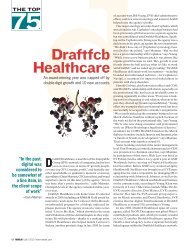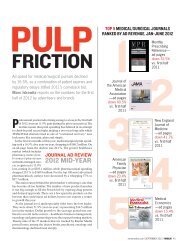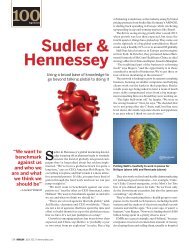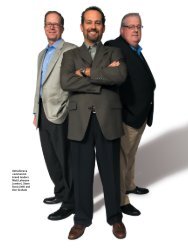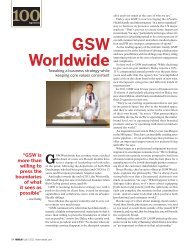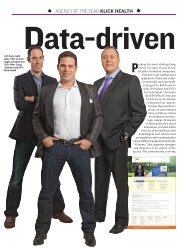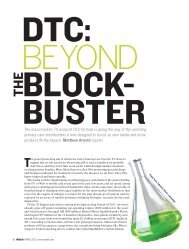Analyze this - Medical Marketing and Media
Analyze this - Medical Marketing and Media
Analyze this - Medical Marketing and Media
Create successful ePaper yourself
Turn your PDF publications into a flip-book with our unique Google optimized e-Paper software.
ANALYZE THIS<br />
Fig.1: Headcount (per br<strong>and</strong>) for marketing<br />
sciences is falling<br />
7.0<br />
6.0<br />
5.0<br />
4.0<br />
3.0<br />
2.0<br />
1.0<br />
0<br />
2.6<br />
6.2<br />
1.4<br />
2.7<br />
1.1<br />
3.0<br />
2006 2007 2008 2009 2010 2011<br />
Primary MR FTEs per br<strong>and</strong><br />
Note: Includes data from 51 manufacturer marketing science operations (MSOP) engagements<br />
Source: TGaS Advisors, MSOPs Database 2006-2011<br />
prophecy,” an outgrowth of the cost-cutting environment researchers<br />
find themselves in: “With reduced [research] headcount, [<strong>and</strong>] the<br />
same number of marketers asking the same amount of questions,<br />
you become less able to think about what you need to be doing next<br />
<strong>and</strong> more focused on the questions that are being asked.”<br />
If they’re not careful, market researchers can become stuck in <strong>this</strong><br />
transactional mode, warns Praveen Advani, director/team leader,<br />
global market research & analytics at Merck. “We have traditionally<br />
seen ourselves as an expert in executing projects <strong>and</strong> providing<br />
recommendations,” Advani tells MM&M. “Frankly, <strong>this</strong> is how we<br />
have been rewarded by our employers. The world is changing.”<br />
And market researchers, Advani says, need to change with it,<br />
adjusting for the new reality of slower product approvals, blockbusters<br />
going off patent <strong>and</strong> generics increasing their presence. “If we don’t<br />
evolve, Market Research could be outsourced <strong>and</strong> the function as<br />
we know it today could soon be obsolete.”<br />
Analytical weak points<br />
So, what are the areas most in need of improvement? Respondents to<br />
the SOI survey spotlight the biggest analytical weak points as being<br />
payer <strong>and</strong> ex-US secondary techniques (see Fig. 7). Notably, these<br />
are also among the areas where they see research spend increasing<br />
the most, in addition to larger outlays for qualitative <strong>and</strong> quantitative<br />
<strong>and</strong> for social media for research.<br />
With managed care <strong>and</strong> government influence holding sway over<br />
therapy choice (Fig. 5), it’s no surprise that respondents are hungry<br />
for better payer analysis. But respondents to the SOI survey, fielded<br />
in November 2011, agreed strongly (8.1) that payer research needs<br />
to improve.<br />
Why is <strong>this</strong> research lacking? Surely, the great fluidity in the payer<br />
market has not helped drug <strong>and</strong> device makers get a h<strong>and</strong>le on it. And<br />
in the past several years, managed markets has become a separate arm<br />
of marketing so, internally a least, manufacturers may still be trying<br />
to figure out a cohesive strategy for incorporating the payer.<br />
There also continues to be very strong agreement that the focus<br />
on global emerging markets will continue. Is an adequate analytical<br />
infrastructure in place overseas to support the added attention? No,<br />
says Merck’s Advani, <strong>and</strong> <strong>this</strong> is a barrier to successful launches,<br />
32 MM&M x MARCH 2012 x mmm-online.com<br />
0.7<br />
2.1<br />
1.1<br />
2.9<br />
0.8<br />
MSOPS FTEs per br<strong>and</strong><br />
1.9<br />
Fig.2: Manufacturers’ research work load has<br />
increased<br />
$1600<br />
Pharma RFPs are very clear<br />
$1200<br />
$800<br />
$849<br />
$930<br />
$400<br />
Pharma underst<strong>and</strong>s use of techniques<br />
0<br />
Note: Primary research spend managed per FTE ($000s)<br />
Source: TGaS Advisors<br />
$1,358<br />
$1,402 $1,397<br />
$1,535<br />
2006 2007 2008 2009 2010 2011<br />
especially for pre-launch products as the focus locally continues to<br />
be on maximizing in-line br<strong>and</strong>s.<br />
Pharma is slowly learning more about the needs of customers<br />
in the BRIC countries in an effort to build a value proposition for<br />
products, but it’s still playing catch-up. “We seem to react <strong>and</strong> not be<br />
as proactive as we should be,” Advani laments. “We have to get ahead<br />
of the curve <strong>and</strong> leverage learnings from other mature markets.”<br />
Another one of the top trends flagged by respondents to the SOI<br />
survey was the strong agreement among manufacturers <strong>and</strong> suppliers/consultants<br />
that secondary data still need to evolve. When<br />
asked to rate, on a 1-10 scale, how many agree that these sources<br />
are satisfactory, total respondents scored US secondary data a 5.5.<br />
Outside the US, the score plummets to a mediocre 3.8.<br />
Notably, medical device secondary data scored much lower than<br />
pharma secondary data. Says TGaS’s Scott, “Pretty much all data<br />
is [subst<strong>and</strong>ard] for them [<strong>and</strong> not just in developing countries]….<br />
It’s an opportunity for somebody to look at that <strong>and</strong> see if they can<br />
build better data sources.”<br />
Device firms want richer insight now, says Michele Fuller, global<br />
head of marketing sciences for Novartis’ Alcon unit. While advancements<br />
in EMRs <strong>and</strong> other technology could bring faster, better data<br />
quality to healthcare providers <strong>and</strong> industry, progress is slow. “Our<br />
ability to perform these analytics is vastly limited, <strong>and</strong> we are in desperate<br />
need of innovation from our suppliers,” she tells MM&M.<br />
But even the bigger suppliers are struggling to exp<strong>and</strong> knowledge<br />
in the emerging markets. Nielsen has offices in 100 countries <strong>and</strong><br />
over the past two years the research giant has seen significantly<br />
increased dem<strong>and</strong> to do primary <strong>and</strong> secondary research in China,<br />
Brazil <strong>and</strong> Russia.<br />
Outside of his own firm’s sizable network, Milos Graonic, SVP,<br />
global pharmaceutical practice leader for Nielsen, says third-party<br />
suppliers willing to collect data <strong>and</strong> find information in these territories<br />
are becoming more commonplace, <strong>and</strong> that’s made it easier to<br />
refine research quality. But while data collection has changed for the<br />
better in these markets, the status of secondary data has not. “Most<br />
often it’s not available <strong>and</strong> when it is, it’s often not reliable.”<br />
As far as primary research goes, researchers need to do “completely<br />
different reads” in the BRIC countries when talking to



